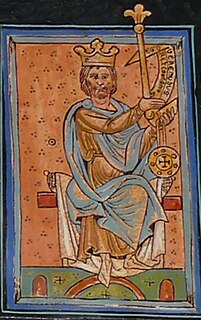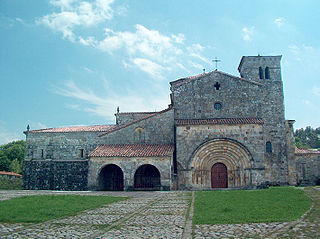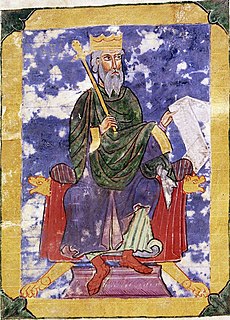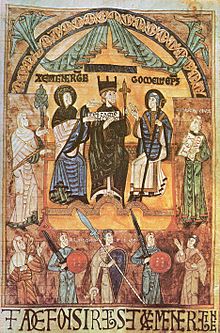
Pelagius was a Visigothic nobleman who founded the Kingdom of Asturias, ruling it from 718 until his death. Through his victory at the Battle of Covadonga, he is credited with beginning the Reconquista, the Christian reconquest of the Iberian peninsula from the Moors. He established an independent Christian state in opposition to Moorish hegemony.

Alfonso V, called the Noble, was King of León from 999 to 1028. Enough is known of him to justify the belief that he had some of the qualities of a soldier and a statesman. Like other kings of León, he used the title emperor to assert his standing among the Christian rulers of Spain. He succeeded his father, Bermudo II, in 999. His mother Elvira García and count Menendo González, who raised him in Galicia, acted as his co-regents. Upon the count's death in 1008, Alfonso ruled on his own.

Oviedo is the capital city of the Principality of Asturias in northern Spain and the administrative and commercial centre of the region. It is also the name of the municipality that contains the city. Oviedo is located approximately 24 km (15 mi) southwest of Gijón and 23 km (14 mi) south of Avilés, both of which lie on the shoreline of the Bay of Biscay. Its proximity to the ocean causes Oviedo to have a maritime climate, in spite of it not being located on the shoreline itself.

The Metropolitan Cathedral Basilica of the Holy Saviour or Cathedral of San Salvador is a Roman Catholic church and minor basilica in the centre of Oviedo, in the Asturias region of northern Spain.

BermudoII, called the Gouty, was first a rival king in Galicia (982–984) and then king of the entire Kingdom of León (984–999). His reign is summed up by Justo Pérez de Urbel's description of him as "the poor king tormented in life by the sword of Almanzor and in death by the vengeful pen of a bishop," Pelagius of Oviedo, half of whose Chronicon covers the reign of Bermudo and is highly critical of the king. He accuses Bermudo of imprisoning Bishop Gudesteus of Oviedo in the 990s and blames the attacks of Almanzor on Bermudo's sins.

The Roman Catholic Diocese of Mondoñedo-Ferrol is the northernmost of the four Latin rite suffragan dioceses in the ecclesiastical province of the Metropolitan Archdiocese of Santiago de Compostela, which covers Galicia in North-western Spain. The area had previously been home to Britonia, a settlement founded by expatriate Britons in the wake of the Anglo-Saxon invasion of Britain. Britonia was represented by the diocese referred to as Britonensis ecclesia in sources from the 6th and 7th centuries.
Elvira García, was Queen consort of Leon by marriage to King Bermudo II, and co-regent of Leon jointly with Count Menendo González during the minority of her son Alfonso V from 999 until 1008.
Pelayo Rodríguez was the Bishop of Iria Flavia (977–985). He was a son of the powerful magnate Rodrigo Velázquez and his wife Adosinda and is usually associated with the conflicts surrounding the accession of Vermudo II after a Galician rebellion in 982.
Flacinus, Flacino, or Flagino was the Bishop of Oviedo between 909 and 912, possibly from as early as 907 until as late as 914. His predecessor was Gomelo II and he first appears in a document of the latter's episcopate, on 20 January 905, signing as both a presbyter and a primicerius. The earliest evidence of his episcopate is a pair of charters for Sahagún in which he signs as Placinius without reference to his see. In 912 when García I made a donation to San Ciprián Flacinus signed as a witness, but again without reference to his see.
Oveco was the Bishop of Oviedo from 913/4, whose episcopate lasted almost half a century. Despite his longevity he is a relatively obscure figure. His origins lie in the same landed and wealthy aristocratic family as those of the Count Piniolo (Piñolo) who founded the monastery of San Juan Bautista de Corias. While the city of Oviedo and its diocese were overshadowed at the time of Oveco's election, at the height of his career, during the turbulent reign of Ramiro II, he was the senior bishop of the realm and his city was labelled the sedem regum.
Diego was the eighth Bishop of Oviedo. The chief source for his life is his will and testament, which survives in the archives of the Cathedral of San Salvador in Oviedo. His episcopate began after the death of his predecessor, Oveco, sometime between 957 and 962.
Bermudo or Vermudo was the ninth Bishop of Oviedo. Historians and clerics Manuel Risco and Carlos González de Posada both date his episcopate to 976–92. Since his predecessor, Diego, is not mentioned in any document after May 971 and no bishop of Oviedo signed the act of the synod that suppressed the Diocese of Simancas in 974, it is presumed that the diocese of Oviedo lay vacant in the early 970s. Bermudo first appears as bishop in a document of 15 March 975 confirming the donation by Cromacio Melliniz and his family of the monastery of San Jorge to the Cathedral of San Salvador and its bishop. Bermudo signs immediately after Ramiro III of León and his regent, Elvira Ramírez.

Gudesteus or Gudesteo was the tenth Bishop of Oviedo. He served as an auxiliary bishop to Bishop Bermudo, perhaps by then old and physically weak, from at least 978 and succeeded him as sole bishop on his death, probably in 992. On folio 49 of the Libro gótico de los testamentos of Oviedo, Bermudo and Gudesteus appear beside each in a miniature illustration.
Hermenegild II was an auxiliary bishop or coadjutor of the Diocese of Oviedo during the episcopates of Gomelo II, Flacinus, and Oveco. He was long mistaken for a senior bishop, as by Carlos González de Posada, who interposed his episcopate in that of Oveco for the years 915–22, and Manuel Risco, who placed it in 921–26.

Martin I was the fifteenth Bishop of Oviedo from 1094.

Fernando Díaz was a Spanish nobleman and military leader in the Kingdom of León, the most powerful Asturian magnate of the period. He held the highest rank in the kingdom, that of count, from at least 24 September 1089. He was the last Count of Asturias de Oviedo and was succeeded by a castellan, a novus homo, perhaps in an ecclesiastical–royal effort to curtail the power of the Asturian aristocracy.

Suero Vermúdez was an Asturian nobleman, extensive landowner, patron of churches, territorial governor, and military leader. He was an important man in León and Castile during the reigns of three monarchs—Alfonso VI, Urraca, and Alfonso VII—all of whom he served with notable loyalty, never taking part in any revolt, but aiding his sovereigns in wars against rebels, against rivals, and against the Moors. The primary sources for the life of Suero are the contemporary narratives the Historia compostellana and the Chronica Adefonsi imperatoris and some 150 surviving charters which make mention of, were drawn up by, or confirmed by Suero. Suero held extensive interests in ecclesiastical properties. Out of his enormous wealth he was a generous patron of monasteries, and appears to have favoured the Benedictines and the Cluniac reform. The Chronica describes Suero, one of the few noblemen it praises, as "a man strong in counsel and a seeker of truth" and "a lover of peace and truth and a faithful friend of the king".
Urraca Alfonso, also known as Urraca the Asturian, illegitimate daughter of Alfonso VII of León, was Queen Consort of Navarre by her marriage to García Ramírez. After becoming a widow, she returned to her homeland and was the regent of Asturias from 1153 to 1165. Urraca was involved in a rebellion against her half-brother, King Ferdinand II of León and with her second husband, Álvaro Rodríguez de Castro attempted to secure the independence of Asturias.

Velasquita Ramírez was Queen consort of León as the first wife of King Bermudo II and mother of infanta Cristina Bermúdez, wife of Ordoño Ramírez.
















